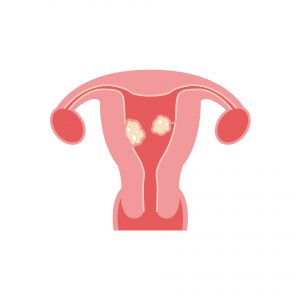About 70% of women will have fibroids at some point in their lives, according to Guido. If this is such a common occurrence, why then are the treatment options so scarce and generally debilitating towards the patient, and why do so few people even know what fibroids are? Many women get fibroids, which are noncancerous tumors that grow within the uterus that do not on their own affect fertility, but traditional treatment leave women infertile.However, there are new treatments that can both treat these tumors while leaving the woman’s fertility unscathed and giving her a fast recovery.
Traditionally, Guido claims the main treatment option for fibroids is to completely remove their source, the uterus, in a hysterectomy procedure . While this does eliminate the possibility of recurrence of fibroids and relieves all symptoms caused by them, by removing the uterus, women are left infertile. This procedure is also extremely invasive and can leave patients with long recovery periods. Leaving the fibroids be is also not an option, even if they are asymptomatic, as they can cause serious issues with pregnancy. Young states that mortality for mothers can range from 25-50% and mortality for the baby is even higher for pregnancies in a fibroid uterus. Many obstetricians will terminate the pregnancy rather than risk the mother carrying to full term. What are prospective mothers to do, should they have fibroids then?
Thanks to advancements in technology, there are some new treatment options for women that hope to maintain fertility and manage their fibroids. One of these options, as explained by Guido, is radiofrequency ablation, which is a technique that uses alternating currents to heat up and kill the tissue of the fibroids. While there is currently only one procedure that is approved by the FDA, called the Acessa procedure, it has shown huge improvements in the lives of many women treated, with their personal evaluation of quality of life improving by an average 82%. Most patients are also released on the same day of the procedure, and due to it being minimally invasive, recovery time is a lot shorter when compared to a hysterectomy. However, there are some downsides, such as this being a new treatment and the studies being very limited in their population sizes. There is also the possibility that further treatment will be needed, according to Guido, should the Acessa procedure not relieve the symptoms, and these further treatments may include an eventual hysterectomy. However, compared to the traditional methods of treatment for fibroids, radiofrequency ablation offers the best chance at relieving symptoms while maintaining fertility.
Another highly effective treatment option while being non-invasive is MR-guided High-Frequency Ultrasound, which uses a beam of ultrasound light to heat up the fibroid tissue and kill it. Siskin states that this procedure requires no incisions and effectively uses MRI to map out the treatment area. This method, although again only studied on a few patients, has the benefit of a quick recovery due to being so minimally invasive. However, according to both Siskin and Guido, the main drawback of this procedure is that it can be easily affected by other issues in the body, such as the bladder or bowel obstructing the ultrasound beam. Should these be present in the patient, this procedure cannot be done at all, leaving this treatment limited in the number of patients it can be helpful towards. Another limitation is that it cannot be used to treat multiple fibroids at once. Although Siskin posits that multiple treatments are theoretically possible but not yet studied. Those that can have the procedure are shown to have their fibroids reduced in size and have minimal pain caused by the procedure, leaving High-Frequency Ultrasound still a good technique to be both minimally invasive and fertility preserving.
Another new treatment is in the form of a drug known as Uliprisal acetate which has been shown in clinical trails to help relieve the symptom of excessive bleeding and reduce fibroid size. As the study by McVeigh states, “many patients [have] anaemia, which complicates surgical treatment options”. In a very credible study, being that it was double-blind and a large population size, Uliprisal acetate was shown to be effective in small doses, although larger doses were shown to have some negative side effects. While this drug is not on its own a complete treatment for fibroids, it can help to lessen the symptoms greatly and for long periods while the patient awaits surgical intervention. However, McVeigh notes that this drug is limited in its capabilities, not being effective on larger fibroids and being only useful to relieve symptoms pre-surgery. Still, being able to manage symptoms before more involved measure can be taken, can greatly improve the quality of life for women with fibroids and may prompt doctors to take less serious surgical measures.
With all these treatment options, women affected by fibroids during their reproductive years certainly have options to maintain their fertility while managing their symptoms. While no procedure will ever be as completely effective in removing the source of the problem as a hysterectomy, treatments such as radiofrequency ablation, high-frequency ultrasound, and drug therapies can all be used to greatly reduce fibroids and their symptoms. These modern procedures have made maintaining fertility and being able to quickly recover from treatments no longer fantasy and the many women who will be affected by fibroids at some point in their lives no longer have to rely on the harsh traditional methods.
By: A Vigil
References
Guido, R., M.D., & Stuparich, M., M.D. (2016). Radiofrequency ablation: New paradigm for treatment of fibroids. Contemporary OB/GYN, 61(10), 12-18. Retrieved from http://libproxy.lib.unc.edu/login?url=https://search.proquest.com/docview/1837164184?accountid=14244
McVeigh, E. (2012), Ulipristal acetate: new oral treatment for uterine fibroids. Prescriber, 23: 17-22. doi:1002/psb.981
Siskin, G. (2006). New Treatments in Uterine Fibroids. Techniques in Vascular and Interventional Radiology, 9(1), 12–18. doi: 10.1053/j.tvir.2006.08.004.
Young. (2007). The treatment of uterine fibroids. The New Zealand Medical Journal (Online), 120(1258) Retrieved from http://libproxy.lib.unc.edu/login?url=https://search.proquest.com/docview/1034235948?accountid=14244
Image Credits
episy2, fibrome uterin, pixabay, https://pixabay.com/illustrations/fibroids-fibroids-model-2947712/
